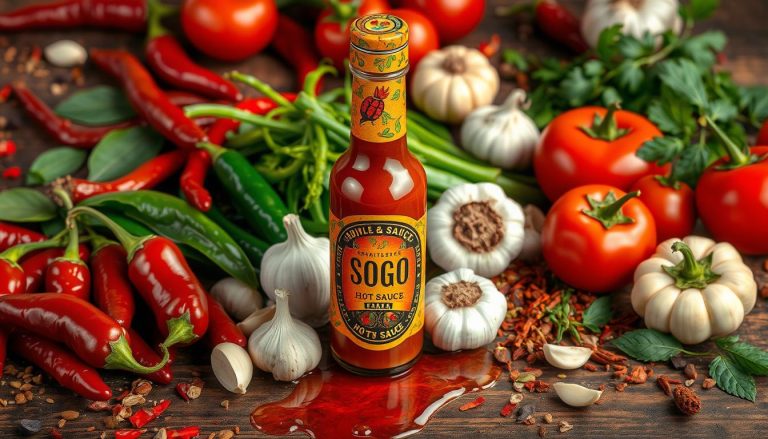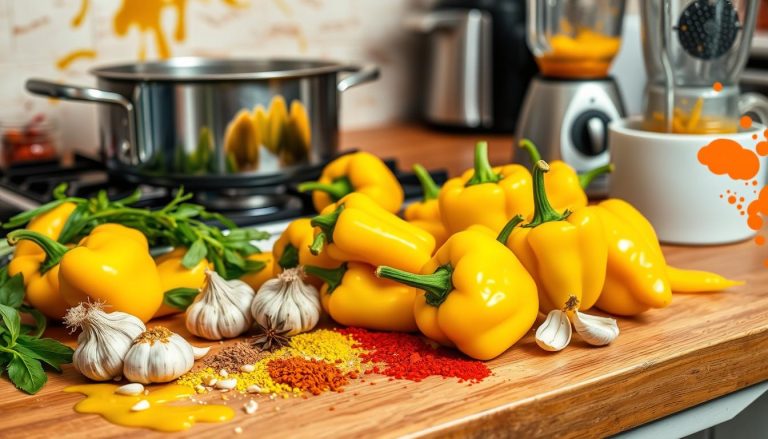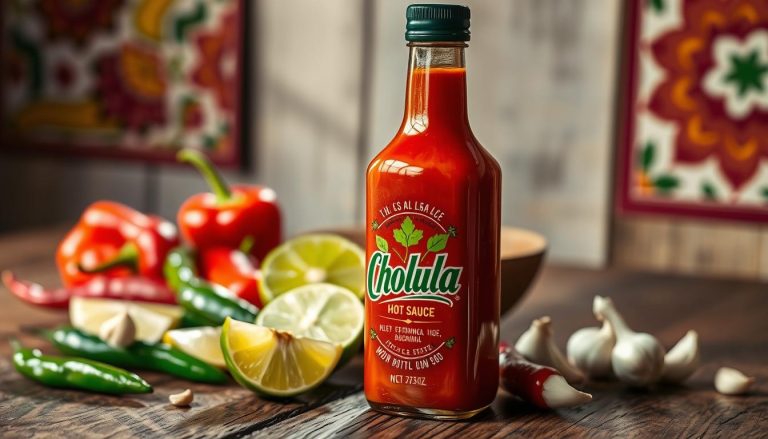Mexican Hot Sauce Recipe [Ultimate DIY Guide]
Details
4 Servings
10 minutes
15 minutes
10–15 calories
Imagine adding a burst of flavor to your favorite dishes with homemade mexican hot sauce. You can make an authentic mexican hot sauce in your kitchen. Use chili peppers, vinegar, and spices to do it.
Mexican hot sauce has a rich history in Mexican cuisine. It’s a staple that can make any meal better. Whether you like mild flavors or intense heat, you can make the perfect sauce for your dishes. This guide will show you how to make a homemade mexican hot sauce that suits your taste.
Exploring mexican hot sauce opens up a world of possibilities. You can use it as a topping for tacos and eggs or add it to your favorite recipes. With this guide, you’ll be on your way to making your own authentic mexican hot sauce. It will soon become a staple in your kitchen.
Table of Contents
Key Takeaways
- You can create a homemade mexican hot sauce using various chili peppers, vinegar, and spices.
- Authentic mexican hot sauce is a staple in Mexican cuisine and can elevate any meal.
- You can tailor your homemade mexican hot sauce to your taste preferences, whether you prefer mild flavors or intense heat.
- Mexican hot sauce is a versatile condiment that can be used as a topping or added to recipes for extra flavor.
- By following this guide, you’ll learn how to make a delicious homemade mexican hot sauce that’s perfect for your favorite dishes.
- Homemade mexican hot sauce can be stored in the refrigerator for up to a week or frozen for up to 3 months.
The Rich History of Mexican Hot Sauce
Mexican hot sauce has a long and interesting history. It goes back thousands of years to ancient Mesoamerican civilizations. You can learn about how traditional mexican hot sauce evolved and its role in today’s food.
The story of Mexican hot sauce is one of change and creativity. Many cultures have shaped its development over time.
Some famous popular mexican hot sauce brands like Valentina, Cholula, and Tapatío are well-known. They’ve made mexican hot sauce names famous worldwide. These brands use old recipes and ingredients to make their sauces special and tasty.
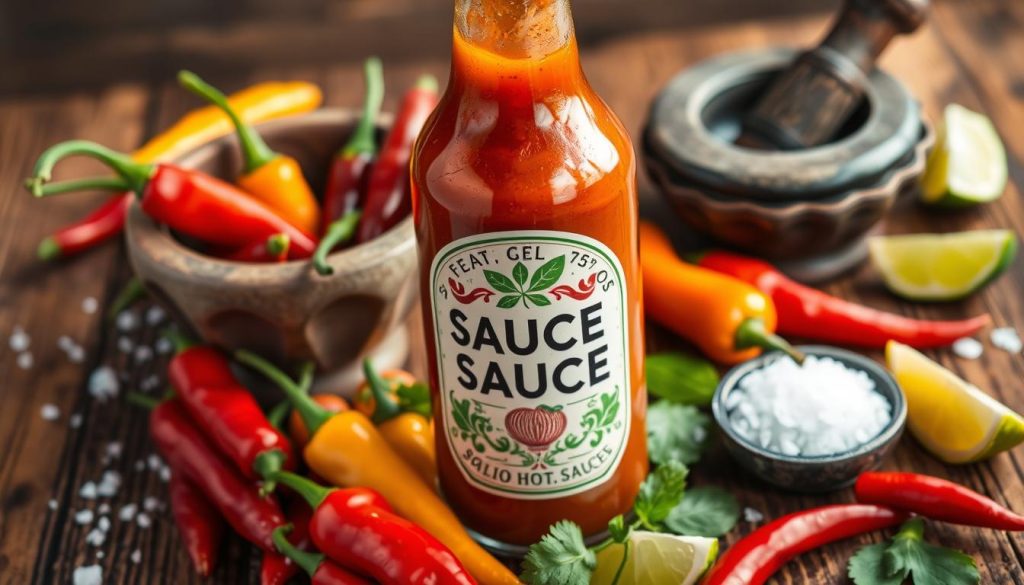
The history of Mexican hot sauce can be broken down into a few key periods:
- Pre-Hispanic era: This time saw the start of chili pepper farming and early hot sauce making.
- Colonial era: New ingredients and methods from Europe and elsewhere changed Mexican hot sauce.
- Modern era: Today, many brands offer Mexican hot sauce. Some stick to traditional ways and ingredients.
Now, Mexican hot sauce is key in many classic dishes like tacos al pastor and pozole. It’s also used in new dishes, as chefs around the world try out different mexican hot sauce types. Its ability to add flavor and heat makes it a favorite in many cuisines.
Essential Ingredients for Mexican Hot Sauce
Making a tasty mexican hot sauce valentina needs the right ingredients. A classic hot sauce from mexico mixes chili peppers, vinegar, garlic, onions, and spices. For a spicy mexican salsa, use jalapeños, serranos, and habaneros. Each chili adds its own heat and taste.
To balance the heat, add vinegar, garlic, and onions. Vinegar’s acidity brings out the flavors. Garlic and onions add a rich taste. Brands like Valentina get their special taste by picking and mixing these ingredients well.
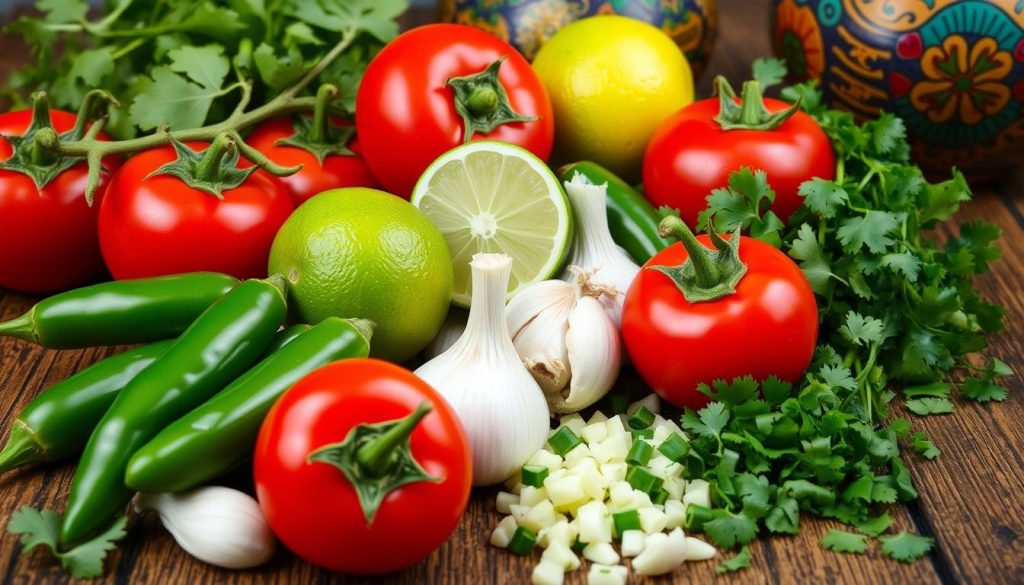
- Chili peppers: jalapeños, serranos, habaneros
- Vinegar: apple cider or white wine
- Garlic: fresh or roasted
- Onions: fresh or caramelized
- Spices: cumin, oregano, or cilantro
By mixing these ingredients right, you can make a delicious and truehot sauce from mexico. It will add flavor and heat to any meal.
Choosing the Right Chiles for Your Sauce
Creating the best mexican hot sauce starts with picking the right chili peppers. You need to find a mix of heat and flavor that makes your dish stand out. With many peppers to choose from, it can feel hard to pick the right ones. Brands like Cholula have mastered mixing peppers to make tasty and unique sauces.
First, think about how spicy you like your sauce. Do you prefer something mild or something that will really spice up your taste buds? The Scoville scale helps you understand the heat of peppers. For example, jalapeños are mild, with a heat level of 2,500 to 8,000 Scoville Heat Units (SHU). Habaneros, on the other hand, are much spicier, with a heat level of 100,000 to 350,000 SHU.
Fresh vs Dried Peppers
Fresh peppers give a bright, vibrant taste. Dried peppers offer a deeper, richer flavor. Mixing both can make your sauce complex and rich. Some popular peppers include:
- Poblanos: mild, rich flavor
- Guajillos: mild to medium, fruity flavor
- Habaneros: extremely hot, fruity flavor
Heat Level Guide
Knowing the heat level of peppers is key to making the perfect sauce. Here’s a simple guide to start with:
- Mild: jalapeños, poblanos
- Medium: serranos, guajillos
- Hot: cayenne, habaneros
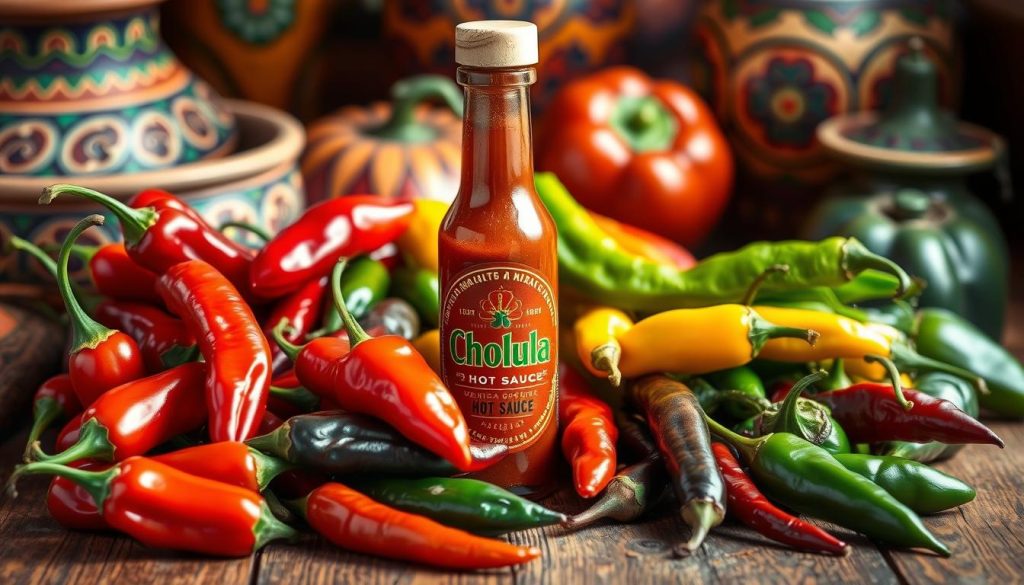
Regional Pepper Varieties
Exploring different pepper varieties can lead to exciting new flavors. Cholula’s sauce is famous for its unique pepper blend. By trying out different peppers, you can make your own special sauce that’s just as good as the best brands.
Required Equipment and Tools
To make your own mexican hot sauce, you’ll need some key tools. A blender or food processor is essential for the right consistency. You’ll also need a saucepan for cooking and a strainer to remove solids. Don’t forget glass bottles for storing your sauce.
For making mexican hot sauce for tacos, a blender is key. It blends chiles, garlic, and spices into a smooth sauce. A saucepan is also needed to heat the sauce to the right temperature. If you want a high-quality mexican hot sauce tapatio, making your own at home is a great idea.
With the right tools, you can make your own delicious mexican hot sauce. It’s perfect for tacos or as a substitute for commercial brands like mexican hot sauce tapatio.
| Equipment | Description |
|---|---|
| Blender | Necessary for achieving the perfect consistency |
| Saucepan | Required for cooking the sauce |
| Strainer | Used to remove any solids |
| Glass bottles | Necessary for storage |
Traditional Mexican Hot Sauce Recipe
To make a traditional mexican hot sauce recipe for tacos, you’ll need certain ingredients. You’ll need 4 tomatillos, 3 tomatoes, and 10 dried árbol chiles. Also, 5 dried guajillo chiles, 2 habaneros, 1 jalapeño, 1 white onion, 3 cloves of garlic, 1 chipotle pepper, and 1/4 bunch of cilantro. These ingredients help create the flavor and spiciness of the traditional mexican red hot sauce recipe.
Making the salsa takes about 20 minutes of prep time. It also needs 20 minutes of cooking time. So, the total time is 40 minutes. This makes the recipe quick and easy, perfect for a taco hot sauce. You can also adjust the flavor by adding lime juice, vinegar, and salt.
| Nutrient | Amount |
|---|---|
| Calories | 19kcal |
| Carbohydrates | 4g |
| Protein | 0g |
| Fat | 0g |
This traditional mexican hot sauce recipe is not only tasty but also vegan-friendly. It has a 4.95-star rating out of 5. This makes it a must-try for anyone seeking an authentic mexican hot sauce recipe for tacos.
Green Mexican Hot Sauce Variation
To make a tangy green hot sauce, mix tomatillos with green chili peppers like jalapeños or serranos. This mexican green chilli sauce recipe is a twist on traditional Mexican salsa. You’ll need 1 lb of tomatillos, 1-3 serrano chiles, 1 large yellow onion, and 3 garlic cloves.
The sauce has a mild to medium heat. It’s great for dipping chips, adding to chicken soup, or making green salsa enchiladas. Feel free to add avocado, corn, cilantro, red onions, lime juice, pepper, sugar or honey, and spices like cumin or smoked paprika. You can also use sour cream or Greek yogurt to make your own pico pica hot sauce recipe.
Some key benefits of this recipe include:
- Approximately 20 servings per batch
- Low calorie count of 44 kcal per serving
- Rich in vitamins and minerals, including vitamin C and potassium
- Can be stored in the refrigerator for up to 4 days or frozen for up to 2 months
By following this mexican green chilli sauce recipe, you can make a delicious green hot sauce. It’s perfect for adding flavor to your favorite dishes. Whether you love spicy foods or want to try something new, this pico pica hot sauce recipe will be a favorite in your kitchen.
Fermented Hot Sauce Method
To make a fermented Mexican hot sauce, you need to know about fermentation. This method, like tabasco’s, lets the mix break down and get richer flavors over time. The sauce tastes deeper and lasts longer.
The fermentation takes about 2 weeks. During this time, the sauce will get tangy. Keep it in a dark place, away from sunlight, at 55-75°F. This helps good bacteria grow, making the sauce better for you.
Fermentation Process
To start, mix chilies, garlic, brown sugar, salt, and vinegar. Use a food processor to blend, then put it in a jar. You can use a 32-oz or two 16-oz jars.
Safety Guidelines
When making fermented hot sauce, safety is key. Use clean tools and a sanitized area. Store it in a sealed jar. Watch for mold or bad smells, and throw it away if you see them.
Troubleshooting Tips
Having trouble? Check the temperature and where you store it. Make sure it’s sealed well. Watch for spoilage signs. With these tips, you can make a tasty, safe sauce like tabasco to enjoy for months.
| Ingredient | Quantity |
|---|---|
| Chilies | 1.5 lbs |
| Garlic | 6 cloves |
| Brown sugar | ¼ cup |
| Kosher salt | 1 tbsp |
| Distilled white vinegar | ½ cup |
Popular Regional Variations
When it comes to what is the most popular mexican hot sauce?, it really depends on where you are. Mexico’s wide range of flavors has led to many different hot sauces. Each region has its own special sauce, with its own taste and heat level.
In Oaxaca, you’ll find smoky sauces. The Yucatán is known for its hot habanero-based sauces. These styles have shaped the what is the famous mexican sauce? we see today. Many brands now offer their own versions of these traditional sauces.
Here are a few examples of popular regional hot sauces:
- Valentina: A popular hot sauce from Guanajuato, known for its mild taste and low heat.
- Cholula: A well-known sauce from Jalisco, loved for its balanced flavor and medium heat.
- El Yucateco: A hot sauce from the Yucatán, famous for its intense heat and unique taste.
These regional hot sauces are not just tasty. They also show how rich and diverse Mexican cuisine is. Whether you prefer a mild sauce or something very spicy, there’s a what is the most popular mexican hot sauce? for you to try.
Serving Suggestions and Pairings
There are many ways to serve your homemade Mexican hot sauce. You can add it to burritos for a spicy twist. Or, try it with tacos, grilled meats, or eggs for a traditional taste.
Using a brand like Tapatío can spark your creativity. Experiment with heat levels to match your taste. You can also mix your hot sauce with other ingredients for new flavors.
Here are some great ways to use your hot sauce:
- Tacos al Pastor with fresh lime juice
- Grilled meats with roasted veggies
- Eggs with cheese and a sprinkle of cheese
- Burritos with beans, rice, and more
When pairing your hot sauce, balance the heat with other flavors. Try different combinations to find your favorite.
| Dish | Pairing Suggestions |
|---|---|
| Tacos al Pastor | Fresh lime juice, grilled onions, cilantro |
| Grilled Meats | Roasted vegetables, sour cream, salsa |
| Eggs | Shredded cheese, diced ham, toasted bread |
| Burritos | Beans, rice, shredded cheese, sour cream |
Storage and Preservation Methods
To keep your homemade Mexican hot sauce fresh, you need to store it right. Brands like valentina show us how to keep quality high. By following their lead, you can enjoy your sauce for months.
Using natural preservatives like vinegar is key. It keeps your sauce fresh longer and tastes better. Also, keep your hot sauce in a cool, dark spot to avoid spoilage.
Here are some tips for storing your homemade hot sauce:
- Refrigerate the sauce to slow down the fermentation process and prevent spoilage.
- Use airtight containers to prevent contamination and spoilage.
- Label and date the containers so you can keep track of how long they have been stored.
By following these tips and learning from brands like tajin, you can enjoy your homemade Mexican hot sauce for a longer period while maintaining its quality and flavor.
| Storage Method | Shelf Life |
|---|---|
| Refrigeration | 6-9 months |
| Canning | 1-2 years |
Common Mistakes to Avoid
When making Mexican hot sauce, it’s key to know common mistakes. These can change the flavor and quality of the sauce. A question often asked is, is Mexican sauce the same as salsa? They’re similar but not the same. Mexican sauce is thicker and has more complex flavors, while salsa is lighter and more acidic.
To avoid mistakes, knowing the differences between hot sauces and salsas is important. Using the wrong vinegar or overcooking peppers can mess up the flavor. Also, bad storage can cause flavor loss or spoilage.
Preparation Errors
Some common mistakes include using bad ingredients, not roasting peppers enough, or not blending the sauce well. To avoid these, use fresh, quality ingredients and follow a good recipe.
Cooking Mishaps
Cooking mistakes can happen when making Mexican hot sauce. Overcooking can make it bitter, while undercooking can make it unbalanced. Cook the sauce over low heat for 10-15 minutes to avoid these issues.
Storage Problems
Storage mistakes can also happen. Always store the sauce in an airtight container in the fridge and use it within a few weeks. By following these tips, you can make a delicious Mexican hot sauce that will enhance your dishes.
Popular Mexican hot sauces include Salsa Roja, Salsa Verde, and Habanero Sauces. Each has its own flavor and heat level. It’s important to pick the right one for your dish. By understanding these differences and avoiding mistakes, you can create a truly authentic and delicious Mexican dish.
| Hot Sauce Type | Flavor Profile | Heat Level |
|---|---|---|
| Salsa Roja | Smoky, slightly sweet | Mild to medium |
| Salsa Verde | Tangy, herbal | Mild to medium |
| Habanero Sauces | Fruity, intense | Very hot |
Health Benefits of Homemade Hot Sauce
Making your own mexican hot sauce is more than just a tasty condiment. It’s also a healthy choice. Capsaicin, the main ingredient, has antioxidants that protect your skin from damage. It also has vitamin C from chili peppers, which is good for you.
Hot sauce, like mexican hot sauce cholula, is low in calories. Most hot sauces have 0-5 calories per teaspoon. It also has some sodium, but it’s not too much. Eating spicy foods, like hot sauce, can help your heart stay healthy.
Hot sauce can also help you lose weight by boosting your metabolism. Capsaicin may help control blood sugar levels too. Some research shows it might even fight cancer by stopping cancer cells from growing.
Here are some key benefits of homemade hot sauce:
- Boosts metabolism and aids in weight management
- May improve heart health by lowering blood pressure and reducing cholesterol levels
- Contains antioxidants that can protect skin cells from damage
- May have cancer-fighting properties
- Low in calories and sodium
Making your own mexican hot sauce is a smart choice. It adds flavor to your meals and might even improve your health. With its many benefits and low calorie count, homemade hot sauce is a better choice than store-bought brands like cholula.
Scaling Your Recipe: From Small Batch to Bulk
Once you’ve got your homemade Mexican hot sauce recipe just right, you might want to make more. Measurement conversions are key to keep the taste and texture the same. To make more, you’ll need to change the amounts of each ingredient. This includes thinking about how long it will cook and what equipment you’ll need.
Some big mexican hot sauce brands, like Valentina, know how to make lots of sauce. By learning from them, you can make a great sauce too. For example, use a bigger pot and cook it longer to heat it up evenly.
Here are some tips to make more of your recipe:
- Double or triple the recipe: Just multiply each ingredient by two or three to make more.
- Adjust the cooking time: Bigger batches might need to cook longer to heat up evenly.
- Use a larger cooking vessel: A bigger pot or saucepan helps cook the sauce better and prevents burning.
By following these tips and using top-notch ingredients, you can make a tasty mexican hot sauce valentina. It’s great for sharing or selling. Always taste and adjust the seasoning to get the best flavor.
| Ingredient | Small Batch | Large Batch |
|---|---|---|
| Chili peppers | 2 cups | 4 cups |
| Onion | 1 cup | 2 cups |
| Garlic | 3 cloves | 6 cloves |
Troubleshooting Your Hot Sauce
When making mexican hot sauce at home, you might face some common issues. These include separation, off-flavors, or heat levels that aren’t consistent. To solve these problems, it’s important to know the causes and find solutions.
If your mexican hot sauce tapatio is too thin, you can fix it. Try using less vinegar or adding more chili peppers to get the right consistency.
Choosing the right chili peppers is key to perfect flavor. With a mexican hot sauce 5 letters name, finding the right heat level is important. Start with a small amount of spicy sauce and adjust it to your taste. Some hot sauces, like Néctar Ígneo, mix sweetness with habanero pepper spiciness.
- Check the freshness of your ingredients, like chili peppers.
- Adjust the vinegar or water to get the right consistency.
- Try different chili peppers to find the perfect heat.
By following these tips and learning about different hot sauces, you can make a delicious mexican hot sauce. It will match your taste preferences perfectly.
Remember, the key to making great hot sauce is to experiment and find the perfect balance of flavors. Don’t be afraid to try new ingredients and adjust the recipe to your liking.
Conclusion
As we wrap up this guide to making Mexican hot sauce, you now know how to make your own delicious salsa picante at home. We’ve covered the history of Mexican hot sauce, from ancient times to today. You’ve also learned about the key ingredients, choosing the right chiles, and traditional ways to make the best Mexican hot sauces.
Making your own hot sauce is fun because you can try new things and create your own special flavor. You can make it just how you like it, whether you want it spicier or with different flavors.
Now, you’re ready to start your own hot sauce-making journey. You can make unique and tasty hot sauces that will make your Mexican dishes even better. Remember, making homemade Mexican hot sauce is all about exploring, being creative, and enjoying the process. Happy saucing!
FAQ
What is the most popular Mexican hot sauce?
What is Mexican hot sauce called?
What is the famous Mexican sauce?
Is Mexican sauce the same as salsa?
What is the five-letter Mexican hot sauce brand?
Recipe Summary
Mexican Hot Sauce Recipe [Ultimate DIY Guide]
Course: Hot saucesCuisine: MexicanDifficulty: Easy4
servings10
minutes15
minutes15
kcal25
minutesThis homemade Mexican hot sauce is a vibrant and spicy condiment made with fresh chili peppers, garlic, onion, and vinegar. It’s quick to prepare, customizable to your heat preference, and perfect for adding a fiery kick to your favorite dishes!
Ingredients
4 medium chili peppers (e.g., jalapeños or 2 habaneros for extra heat)
1 clove garlic, peeled
¼ medium onion, diced
1 small tomato (optional)
¼ cup white or apple cider vinegar
½ tsp salt (or to taste)
Directions
- Prepare the Ingredients
Remove the stems from the chili peppers and deseed them if you prefer a milder sauce. Rinse and pat dry.
Dice the onion and peel the garlic. - Cook the Aromatics
Heat 1 teaspoon of oil in a small saucepan over medium heat.
Sauté the garlic, onion, and tomato (if using) for 3–4 minutes until softened and fragrant. - Blend the Ingredients
Add the sautéed mixture, chili peppers, vinegar, salt, and any optional spices to a blender.
Blend until smooth. If the sauce is too thick, add 1–2 tablespoons of water to reach your desired consistency. - Simmer the Sauce
Pour the blended mixture back into the saucepan.
Simmer over low heat for 5–7 minutes, stirring occasionally, to meld the flavors. Taste and adjust seasoning if needed. - Cool and Store
Let the sauce cool completely.
Transfer to a sterilized glass jar or bottle. Refrigerate for up to 2 weeks.
Notes
- Adjust Heat Level: For a milder sauce, use fewer chili peppers or remove the seeds. For extra heat, add spicier peppers like habaneros or serranos.
Add Depth of Flavor: Experiment with smoked chilies like chipotles or toasted spices like cumin and paprika for a richer taste.
Fermentation Option: For a tangier and more complex flavor, let the blended mixture ferment in a jar for 1–2 weeks before simmering.
Storage Tips: Use sterilized containers to extend the shelf life, and always refrigerate the sauce.
Experiment with Variations: Add ingredients like roasted garlic, charred tomatoes, or fresh herbs to customize your sauce.
This recipe is versatile and easy to tweak, so don’t hesitate to get creative!

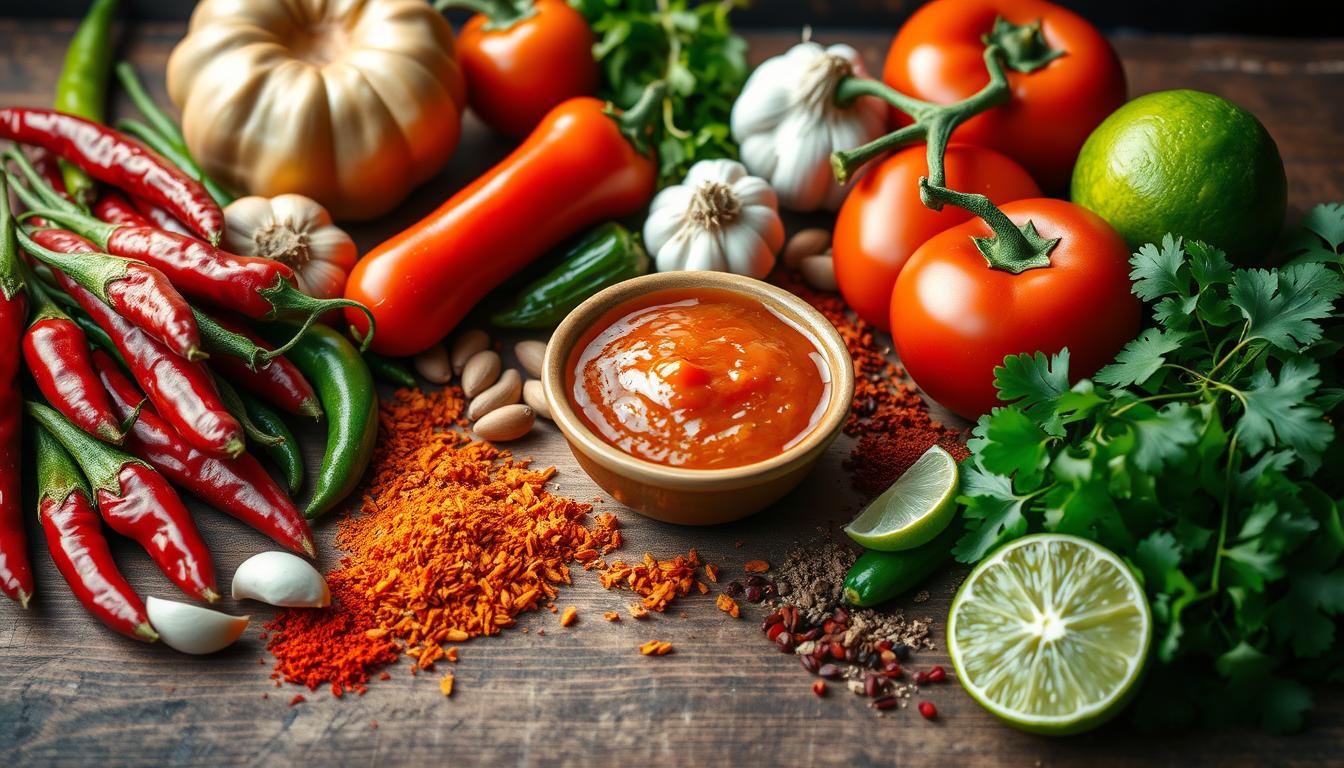

![Mexican Hot Sauce Recipe [Ultimate DIY Guide]](https://saucerecipes.blog/wp-content/uploads/2024/12/mexican-hot-sauce-800x530.jpg)


